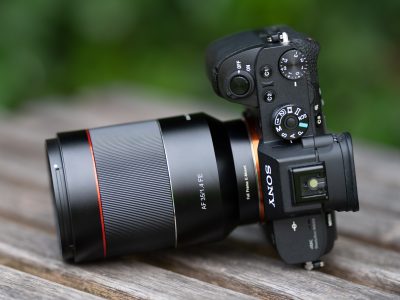Samyang AF 35mm f1.4 FE review
-
-
Written by Thomas
Quality
Testing: Longitudinal Chromatic Aberration and focus shift
Lenses with focal ratios of f2.8 or larger are often prone to longitudinal color aberrations (loCA, a.k.a. “axial color” or “Bokeh CA”). These normally show up as magenta coloration in the foreground and greenish hues in the background and are not easily corrected in post-processing. The Samyang AF 35mm f1.4 FE shows some loCA. The following 100% crops show the foreground on the left and the background on the right with the first crop at f1.4, second at f2.0, third at f2.8:
Longitudinal Chromatic Aberration (loCA)
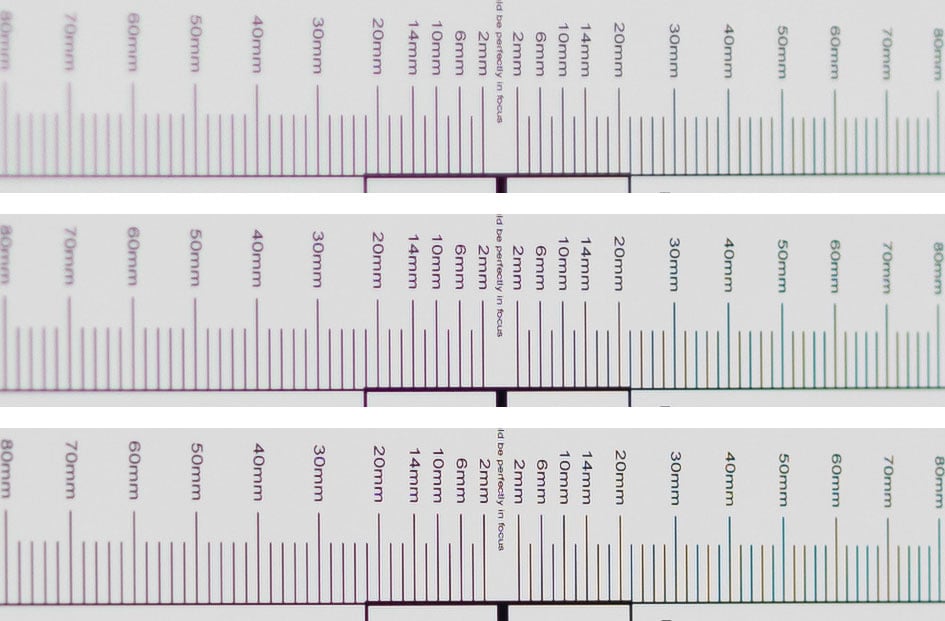
Above: Samyang AF 35mm f1.4 FE at f1.4, f2.0, f2.8; 100% crops
The test also revealed that there is no focus shift. For comparison have a look at the Sony FE 35mm f1.4 ZA which has pretty prominent loCA , Sony FE 35mm f1.8 at f1.8, f2.0 and f2.8, Sigma 35mm f1.4 Art, Sigma 35mm f1.2 DG DN Art. All f1.4 lenses are shown at f1.4/f2.0/f2.8, the f1.2 Sigma Art at f1.2/f1.4/f2.0/f4.0.
The following real life shot shows that the Sigma 35mm f1.2 DG DN Art produces some purple fringing around high-contrast edges in the focal plane and green outlining around background subjects:

Above: Samyang AF 35mm f1.4 FE at f1.4; 100% crop; click image to access 4k version
But purple fringing around specular highlights and loCAs are not very prominent as the shots of fountains on the samples page show.
Sharpness and contrast
Let’s have a look at the theoretical performance of the Samyang AF 35mm f1.4 FE first and compare it to some alternatives:
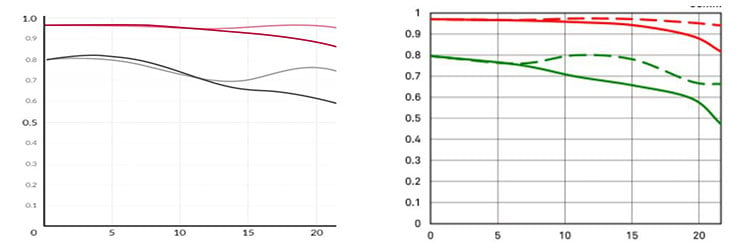
Above: MTF Samyang AF 35mm f1.4 FE (left), Sigma 35mm f1.2 DG DN Art (right)
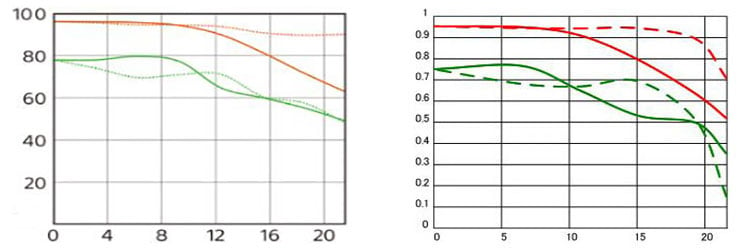
Above: MTF Sony FE 35mm f1.8 (left), Sigma 35mm f1.4 Art (right)
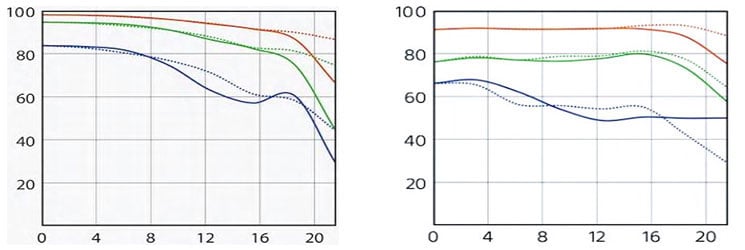
Above: MTF Sony FE 35mm f2.8 ZA (left), Sony 35mm f1.4 ZA (right)
The MTF charts of the Zeiss (designed) ZA lenses from Sony show the contrast wide open at 10 (red), 20 (green) and 40 line-pairs per mm (purple). The computed MTF chart of the other lenses from Sony, Samyang and Sigma shows contrast at 10 lp/mm (red) and 30 lp/mm (green) wide open without influence of diffraction. Higher values are better (more contrast) and the closer the solid and dotted lines are together the less astigmatism (= resolution depends on the orientation of the test-pattern) the lens has. The x-axis displays the distance from the optical axis (=center of the sensor) in mm. I’ll show you the real-life performance at 4 mm (center), 13 mm (APS-C-corner), and 20 mm (FF-corner) on a 42MP Sony A7R II body.
On paper the Samyang AF 35mm f1.4 FE looks almost as good as the Sigma 35mm f1.2 DG DN Art while all other lenses show a clear dip in sharpness around 12-15mm off-center. But other than that the different methodologies and different focal ratios used in these charts makes it hard to compare these lenses. So let’s see how they perform in my sharpness test based on Siemens-stars. Processing was done in Lightroom 8/CRAW 11 from RAW to Adobe Color profile using the built-in lens profile where applicable. Noise-reduction is set to 0, sharpening to 50/0.5/36/10, with no extra tone, color, or saturation adjustment. White-balance was adjusted to a neutral white and I did some exposure compensation to make the brightness of all crops match. So you will not see light fall-off in the corners.
The following 100% crops show the Samyang AF 35mm f1.4 FE from f1.4 down to f11 compared to the Sony FE 35mm f1.4 ZA, Sigma 35mm f1.2 DG DN Art, Sigma 35mm f1.4 Art (shot on a 36MP Nikon D800) at f1.4, and the Sony FE 35mm f1.8 at f1.8.
Samyang AF 35mm f1.4; 100% crop from center, APS-C-corner, FF-corner

Above: Samyang AF 35mm f1.4 FE at f1.4

Above: Sigma 35mm f1.2 DG DN Art at f1.4; also available at f1.2, f1.7, f2.0, f2.8, f4.0, f5.6, f8.0, f11

Above: Sony FE 35mm f1.4 ZA at f1.4; also available at f1.7, f2.0, f2.8, f4.0, f5.6, f8.0, f11

Above: Sigma 35mm f1.4 Art on a 36MP Nikon D800 at f1.4; also available at f2.0, f2.8
At f1.4 the Sigma 35mm f1.2 DG DN Art is the best here followed by the Samyang AF 35mm f1.4 FE which is just a bit softer in the center. The Sony FE 35mm f1.4 ZA is almost as sharp as the Sigma in the center but cannot keep up toward the corners. And the Sigma 35mm f1.4 Art is surprisingly sharp in the FF-corner but its APS-C-corner is the softest in this comparison.

Above: Samyang AF 35mm f1.4 FE at f1.7

Above: Sony FE 35mm f1.8 at f1.8
At f1.7/f1.8 the Samyang AF 35mm f1.4 FE and the Sony FE 35mm f1.8 are of comparable sharpness with the center a tad sharper from the Sony and the FF-corner a little sharper from the Samyang.
Now let’s see how the Samyang AF 35mm f1.4 FE develops when stopped down further:

Above: Samyang AF 35mm f1.4 FE at f2.0

Above: Samyang AF 35mm f1.4 FE at f2.8

Above: Samyang AF 35mm f1.4 FE at f4.0

Above: Samyang AF 35mm f1.4 FE at f5.6

Above: Samyang AF 35mm f1.4 FE at f8.0

Above: Samyang AF 35mm f1.4 FE at f11
Stopping the Sigma 35mm f1.2 DG DN Art down beyond f2.8 does not gain much. The test also revealed that there is quite some field curvature at this shooting distance.
Performance at long distances
The Siemens-star test-targets are shot at a distance of 45x focal length (i.e. at around 1.6m). But as performance of lenses also depends on the shooting distance I did another series of test-shots of a city around 1 km away. Processing was done in Lightroom 8/CRAW 11 from RAW to Adobe Color profile with the lens-profile automatically applied. Noise-reduction is set to 0, sharpening to 50/0.5/36/10, with no extra tone, color, or saturation adjustment. I used autofocus at the largest aperture and did not change focus for other apertures.
The main image shows the complete scene wide open to give you an impression of the angle of view and to judge vignetting. You can access the respective shots up to f11 via the links beneath the main image. Following the main image are 100% crops from the Samyang AF 35mm f1.4 FE from f1.4 down to f11 compared to the Sony FE 35mm f1.4 ZA, Sigma 35mm f1.2 DG DN Art at f1.4, and Sony FE 35mm f1.8 at f1.8. All lenses were shot on the same day only minutes apart except for the Sony FE 35mm f1.4 ZA.
You can click on each image to access the large original. Please respect our copyright and only use those images for personal use.
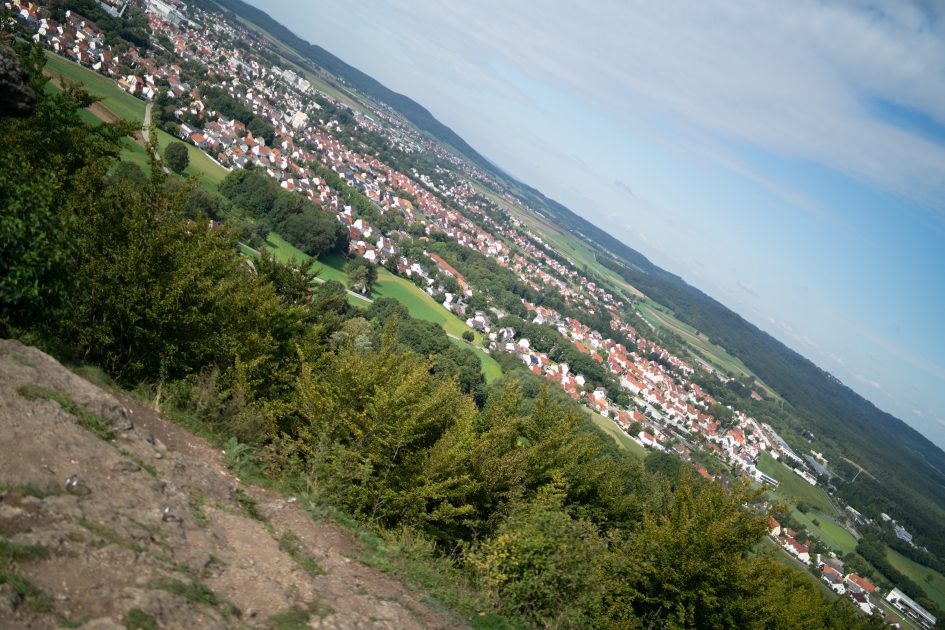
Above: Samyang AF 35mm f1.4 FE at f1.4; click image for 4k version, also available as large original at f1.4, 1.7, f2.0, f2.8, f4.0, f5.6, f8.0, f11

Above: Samyang AF 35mm f1.4 FE at f1.4; 100% crop from center, APS-C-corner, FF-corner

Above: Sigma 35mm f1.2 DG DN Art at f1.4; 100% crop from center, APS-C-corner, FF-corner; also available as large original at f1.2, f1.4, f1.7, f2.0, f2.8, f4.0, f5.6, f8.0, f11

Above: Sony FE 35mm f1.4 ZA at f1.4; 100% crop from center, APS-C-corner, FF-corner; available as large original at f1.4, f1.6, f1.7, f2.0, f2.8, f4.0, f5.6, f8.0, f11
Again, the Sigma 35mm f1.2 DG DN Art is the best at f1.4 closely followed by the Sony FE 35mm f1.4 ZA and the Samyang AF 35mm f1.4 FE. All three lenses show a smidge of purple fringing in the center (strongest with the Sony) and both the Samyang and the Sony suffer from field curvature which leads to front-focus at the APS-C-corner: The tree in the foreground is sharper than the background.

Above: Samyang AF 35mm f1.4 FE at f1.7; 100% crop from center, APS-C-corner, FF-corner

Above: Sony FE 35mm f1.8 at f1.8; 100% crop from center, APS-C-corner, FF-corner; available as large original at f1.8, f2.0, f2.8, f4.0, f5.6, f8.0, f11
The Sony FE 35mm f1.8 is a tad better than the Samyang AF 35mm f1.4 FE at f1.8: It suffers a bit less from field-curvature at the APS-C corner and has the slightly sharper FF-corner.
Let’s see how the Samyang AF 35mm f1.4 FE develops when stopped down further:

Above: Samyang AF 35mm f1.4 FE at f2.0; 100% crop from center, APS-C-corner, FF-corner

Above: Samyang AF 35mm f1.4 FE at f2.8; 100% crop from center, APS-C-corner, FF-corner

Above: Samyang AF 35mm f1.4 FE at f4.0; 100% crop from center, APS-C-corner, FF-corner

Above: Samyang AF 35mm f1.4 FE at f5.6; 100% crop from center, APS-C-corner, FF-corner

Above: Samyang AF 35mm f1.4 FE at f8.0; 100% crop from center, APS-C-corner, FF-corner

Above: Samyang AF 35mm f1.4 FE at f11; 100% crop from center, APS-C-corner, FF-corner
The field-curvature at the APS-C corner is pretty persistent: You need to stop down to f4.0 or even f5.6 to get rid of it.
Rendering of point-light sources at night-shots
Night-shots pose a different challenge for lenses as the contrast is even higher than under bright sun and point-light sources can reveal some weaknesses such as coma, haloing and color-aberrations that do not show up as prominently in other test-shots. The 100% crops below the main image show the effect of coma in the FF-corner of the Samyang AF 35mm f1.4 FE and the other lenses at various apertures:
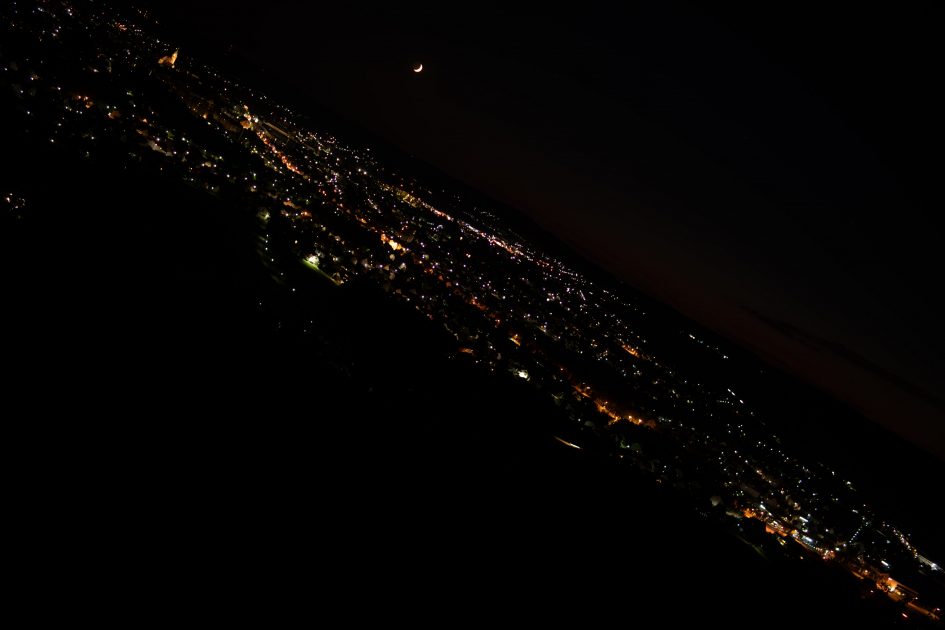
Above: Samyang AF 35mm f1.4 FE at f1.4; click image for 4k version, also available as large original at f1.4, 1.7, f2.0, f2.8, f4.0, f5.6, f8.0

Above: Samyang AF 35mm f1.4 FE; 100% crops from the FF-corner at f1.4 (left), f2.0 (middle), f2.8 (right)

Above: Sigma 35mm f1.2 DG DN Art; 100% crops from the FF-corner at f1.2 (left), f1.4 (middle), f2.0 (right)

Above: Sony FE 35mm f1.4 ZA; 100% crops from the FF-corner at f1.4 (left), f2.0 (middle), f2.8 (right)

Above: Sony FE 35mm f1.8; 100% crops from the FF-corner at f1.8 (left), f2.0 (middle), f2.8 (right)
That’s quite a surprise how little coma the Sigma 35mm f1.2 DG DN Art (at f1.2!) and the Samyang AF 35mm f1.4 FE show. They are followed by the Sony FE 35mm f1.4 ZA. The Sony FE 35mm f1.8 ranks last – although it has the slowest focal ratio.
Rendering of out-of-focus point-light sources
This test is for the rendering of point-light sources in an out-of-focus background. The circle of confusion that is produced by this test is pretty indicative of Bokeh performance (in the background) and light fall-off. Ideally the out-of-focus image of the point-light is evenly lit and perfectly circular, with no “onion-rings”, and without coloration. Large aperture lenses normally produce an effect known as “cat’s eye” the further away from the optical axis the point-light is projected. This is due to optical vignetting in the lens barrel when light enters the lens from an angle.
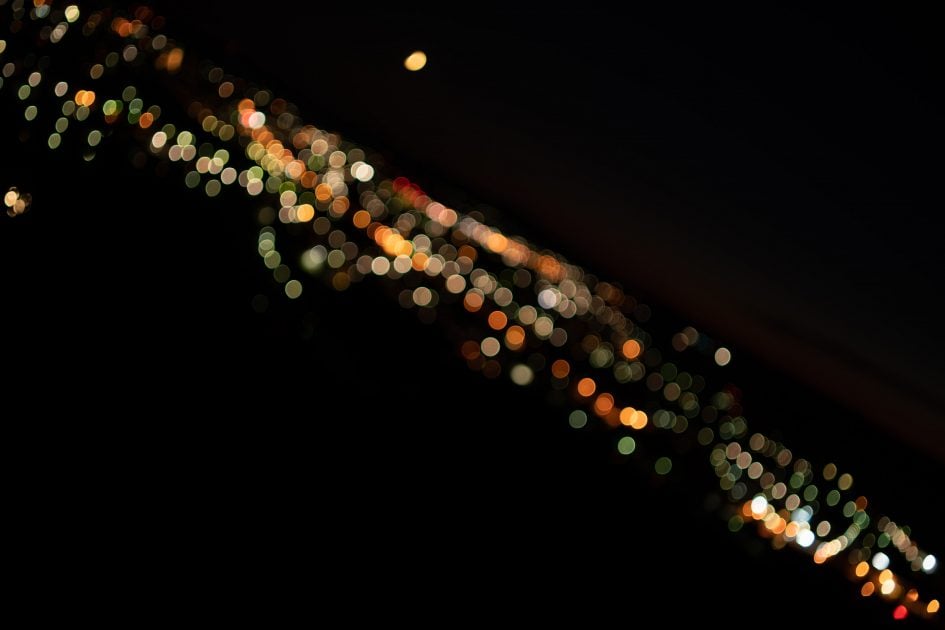
Above: Samyang AF 35mm f1.4 FE at f1.4; click image for 4k version, also available as large original at f1.4, 1.7, f2.0, f2.8, f4.0, f5.6, f8.0

Above: Samyang AF 35mm f1.4 FE at f1.4; 46% crops from center, APS-C-corner, FF-corner

Above: Sigma 35mm f1.2 DG DN Art at f1.2; 46% crops from center, APS-C-corner, FF-corner; also available as large original at f1.2, f1.3, f1.4, f1.7, f2.0, f2.8, f4.0, f5.6, f8.0

Above: Sony FE 35mm f1.4 ZA at f1.4; 46% crops from center, APS-C-corner, FF-corner; also available as large original at f1.4, f2.0, f2.8, f4.0, f5.6, f8.0

Above: Sony FE 35mm f1.8 at f1.8; 46% crops from center, APS-C-corner, FF-corner; also available as large original at f1.8, f2.0, f2.8, f4.0, f5.6, f8.0
The larger the aperture, the larger the Bokeh balls in the center. Thus the f1.2 Sigma Art leads and the f1.8 Sony is last – not only regarding the size of the Bokeh balls in the center but in this case also in the corners. Both the Samyang AF 35mm f1.4 FE and the Sony FE 35mm f1.4 ZA produce visible onion rings while the Sigma 35mm f1.2 DG DN Art and the Sony FE 35mm f1.8 have much smoother texture inside. Outlining is strongest with the Samyang and a little milder on the f1.8 Sony. All lenses show a slight green coloration from loCA. Looking in the FF-corner the Sigma has the strongest cat’s eye effect, followed by the f1.4 Sony. Interestingly the Samyang shows some clipping there. That’s an effect one seldom sees on mirrorless cameras.
Let’s see how this analysis of out-of-focus point-light sources translates into Bokeh-performance shooting a book-shelf.
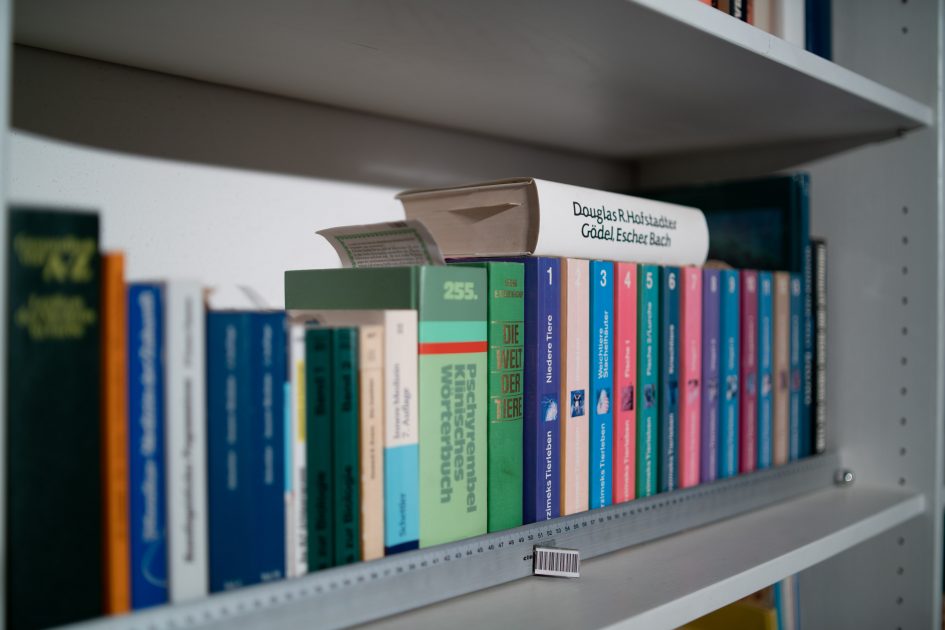
Above: Samyang AF 35mm f1.4 FE at f1.4; click image for 4k version, also available as large original at f1.4, 1.7, f2.0, f2.8, f4.0, f5.6, f8.0

Above: Samyang AF 35mm f1.4 FE at f1.4; 46% crops from foreground, middle-ground, background

Above: Sigma 35mm f1.2 DG DN Art at f1.2; 46% crops from foreground, middle-ground, background; also available as large original at f1.2, f1.4, f1.7, f2.0, f2.8, f4.0, f5.6, f8.0

Above: Sony FE 35mm f1.4 ZA at f1.4; 46% crops from foreground, middle-ground, background; also available as large original at f1.4, f2.0, f2.8, f4.0, f5.6, f8.0

Above: Sony FE 35mm f1.8 at f1.8; 46% crops from foreground, middle-ground, background; also available as large original at f1.8, f2.0, f2.8, f4.0, f5.6, f8.0
From the comparison above it is clear that the larger focal ratio (potentially) produces the better Bokeh: The Sigma Art leads in this comparison (again) followed closely by the Sony FE 35mm f1.4 ZA. And the Sony FE 35mm f1.8 clearly suffers from its f1.8 focal ration. But the Samyang shows that focal ratio is not everything when it comes to the quality of Bokeh: although shot at the same f1.4 aperture it exhibits a more nervous background and a less soft transition in the middle-ground than the Sony FE 35mm f1.4 ZA.
Portrait performance
35mm focal length may not be the classical choice for portraits on a full-frame camera but the Samyang AF 35mm f1.4 FE can well be used for upper body or full body shots when you get close enough. And it offers an angle of view equivalent to a 53mm lens on a cropped APS-C sensor. Plus the background blur at closer shooting distances is nice enough to give it a try. All shots were done from the same position/distance so perspective does not change between shots. There is slightly different framing from different effective focal length at the shooting distances and there are also some slight focus-differences which inevitably occur when you shoot a living, breathing subject. All images were developed from RAW to Adobe Color profile with identical white balance.
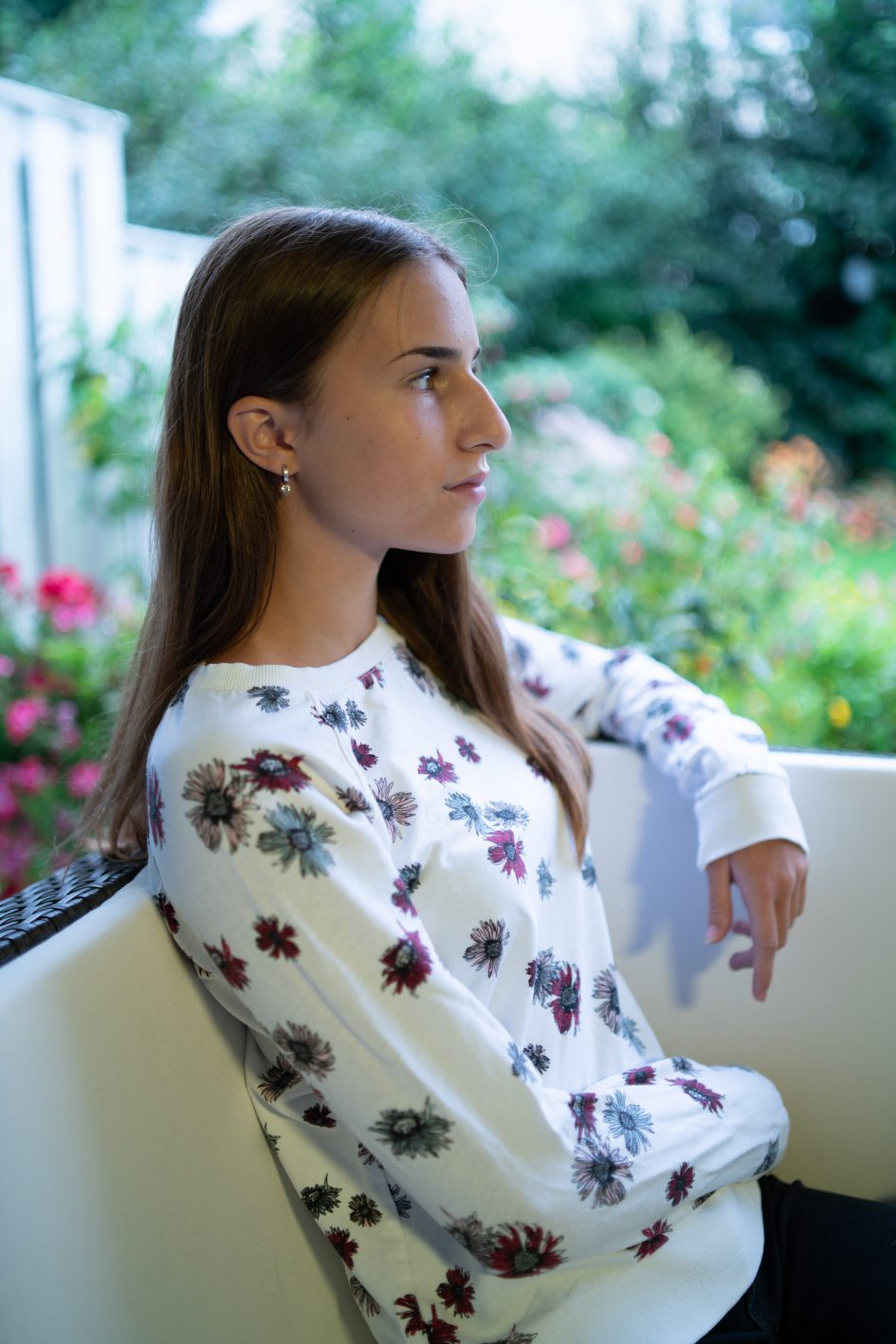
Above: Samyang AF 35mm f1.4 FE at f1.4; click image for 4k version, also available as large original at f1.4, f1.7, f2.0, f2.8, f4.0

Above: Samyang AF 35mm f1.4 FE at f1.4, 50% crop; click image to view 100% crop

Above: Sigma 35mm f1.2 DG DN Art at f1.2, 50% crop; click image to view 100% crop, also available as large original at f1.2, f1.4, f1.7, f2.0, f2.8, f4.0

Above: Sony FE 35mm f1.8 at f1.8, 50% crop; click image to view 100% crop, also available as large original at f1.8, f2.0, f2.8, f4.0
Close-up performance
The Samyang AF 35mm f1.4 FE goes down to 1:5.3 magnification. But to get a usable performance it’s better to stop down to at least f5.6 or f8.0. The following image was shot at 1:6 magnification where the area of sharp focus is just 144 x 216mm. The crops shown below are (from left to right) from 2mm, 9mm, and 18mm off the center of the sensor respectively:

Above: Samyang AF 35mm f1.4 FE at f2.8, 1:6 magnification; 100% crops

Above: Samyang AF 35mm f1.4 FE at f4.0, 1:6 magnification; 100% crops

Above: Samyang AF 35mm f1.4 FE at f8.0, 1:6 magnification; 100% crops
Flare, ghosting, and sun-stars
Catching a strong light-source shining directly into the lens is always a risky business: it could produce strange colorful ghost-images or reduce contrast considerably through flare and glare. The appearance of flare and ghosting depends on factors like the aperture and the angle of the light hitting the lens. So to judge the proclivity of the Samyang AF 35mm f1.4 FE for these artifacts I went through a series of well calculated shots against a strong light source to provoke glare and ghosting. The lens hood was mounted in all shots. Following are two of the more extreme example results. The little bright square inset in the upper left shows the respective area with an exposure compensation of +3 EV to make it easier to see which levels of black the lens renders at that point:
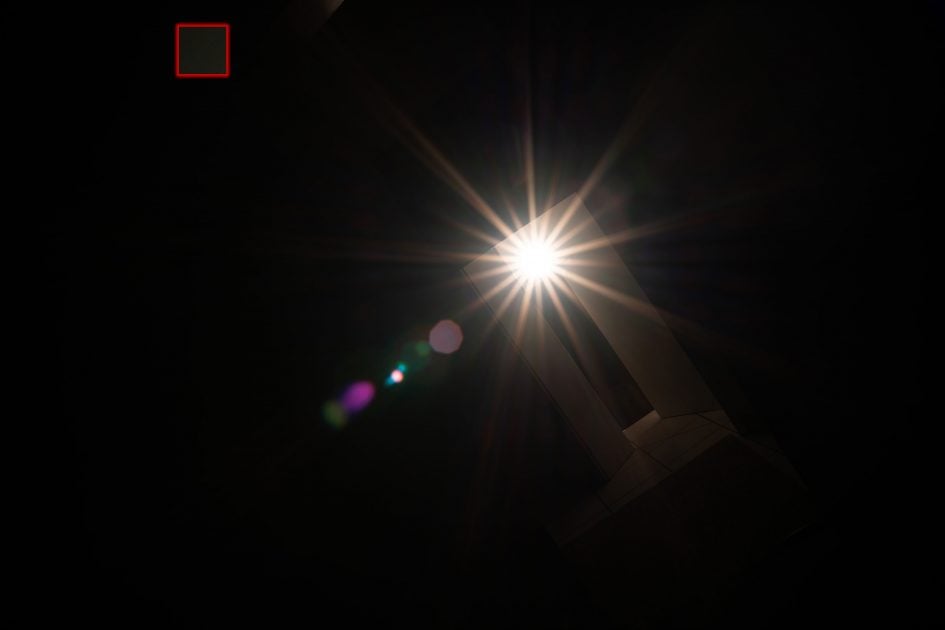
Above: Flare and ghosting. Strong light hitting the Samyang AF 35mm f1.4 FE at f11; click image for 4k version or here for +3 EV exposure compensation
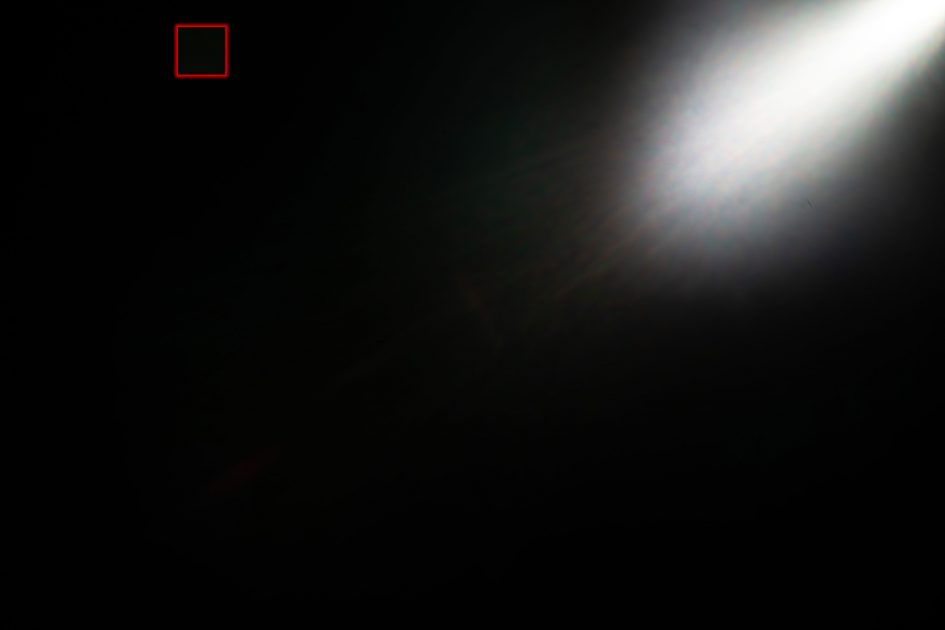
Above: Flare and ghosting. Strong light hitting the Samyang AF 35mm f1.4 FE at f11; click image for 4k version or here for +3 EV exposure compensation
Flare and ghosting is not well controlled as you can see in the sample images above. But where those artifacts do not hit the level of black is pretty good, so glare is generally not a problem. The sunstar in the top image looks well defined although the lens creates different length of spikes. The bright flare from the upper right in the second image occurs at a pretty broad angle when the light-source is outside the corner. This is worse than from other lenses I’ve tested so far. For comparison have a look at the Sony FE 35mm f1.4 ZA here and here.
All-in-all you have to watch out when shooting the Samyang AF 35mm f1.4 FE under adverse contra-light situations.
Next check out my sample images!
Check prices on the Samyang AF 35mm f1.4 FE at Amazon, B&H, Adorama, or Wex. Alternatively get yourself a copy of my In Camera book or treat me to a coffee! Thanks!




